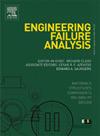Lessons learned from a crack assessment of a 36-inch steam header operating at high pressure and temperature
IF 4.4
2区 工程技术
Q1 ENGINEERING, MECHANICAL
引用次数: 0
Abstract
A leaking crack in a high-pressure steam header, manufactured from carbon steel, was assessed for acceptability according to the precepts of the API 579-1/ASME FFS-1 2021 Fitness-For-Service standard. A finite element model, with shell elements in the line section, combined with solid elements in the region of interest, was constructed to gain insight into the through-thickness stress distribution. A basic linear elastic methodology, utilizing a lower-bound estimate of fracture toughness, indicated that the crack was acceptable for continued operation, albeit with a small margin of safety. Five other evaluations, four of which were based on ductile tearing criteria, were performed and it was found that the limiting crack size was in fact larger than the assessed crack with a substantial margin. The most accurate assessment performed used ductile tearing instability as the limiting criterion, with the tearing analysis supported by test results obtained from service-exposed samples. A J-integral tearing resistance (J-R) curve was experimentally established at the operational temperature, using a section cut from the header. The outcomes of the six assessments were critically compared with regard to damage tolerance and conclusions were drawn from these comparisons.
从高压高温下运行的36英寸蒸汽集箱裂缝评估中获得的经验教训
根据API 579-1/ASME FFS-1 2021服务适用性标准的规定,对碳钢制造的高压蒸汽集箱中的泄漏裂缝进行了可接受性评估。建立了以线段为壳单元,感兴趣区域为实体单元的有限元模型,以深入了解贯穿厚度的应力分布。一种基本的线性弹性方法,利用断裂韧性的下限估计,表明裂纹是可以接受的,尽管有很小的安全余地。另外进行了五次评估,其中四次是基于韧性撕裂标准,发现极限裂纹尺寸实际上比评估的裂纹大得多。最准确的评估是使用韧性撕裂不稳定性作为极限准则,而撕裂分析得到了来自服务暴露样品的测试结果的支持。在工作温度下,通过实验建立了j积分撕裂阻力(J-R)曲线。对六种评估的结果进行了损伤容限的严格比较,并从这些比较中得出结论。
本文章由计算机程序翻译,如有差异,请以英文原文为准。
求助全文
约1分钟内获得全文
求助全文
来源期刊

Engineering Failure Analysis
工程技术-材料科学:表征与测试
CiteScore
7.70
自引率
20.00%
发文量
956
审稿时长
47 days
期刊介绍:
Engineering Failure Analysis publishes research papers describing the analysis of engineering failures and related studies.
Papers relating to the structure, properties and behaviour of engineering materials are encouraged, particularly those which also involve the detailed application of materials parameters to problems in engineering structures, components and design. In addition to the area of materials engineering, the interacting fields of mechanical, manufacturing, aeronautical, civil, chemical, corrosion and design engineering are considered relevant. Activity should be directed at analysing engineering failures and carrying out research to help reduce the incidences of failures and to extend the operating horizons of engineering materials.
Emphasis is placed on the mechanical properties of materials and their behaviour when influenced by structure, process and environment. Metallic, polymeric, ceramic and natural materials are all included and the application of these materials to real engineering situations should be emphasised. The use of a case-study based approach is also encouraged.
Engineering Failure Analysis provides essential reference material and critical feedback into the design process thereby contributing to the prevention of engineering failures in the future. All submissions will be subject to peer review from leading experts in the field.
 求助内容:
求助内容: 应助结果提醒方式:
应助结果提醒方式:


